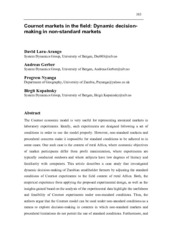Cournot markets in the field: Dynamic decision- making in non-standard markets
Conference lecture
Accepted version

View/
Date
2017Metadata
Show full item recordCollections
- Department of Geography [627]
Abstract
The Cournot economic model is very useful for representing atomized markets in laboratory experiments. Ideally, such experiments are designed following a set of conditions in order to use the model properly. However, non-standard markets and procedural concerns make it impossible for standard conditions to be adhered to in some cases. One such case is the context of rural Africa, where economic objectives of market participants differ from profit maximization, where experiments are typically conducted outdoors and where subjects have low degrees of literacy and familiarity with computers. This article describes a case study that investigated dynamic decision-making of Zambian smallholder farmers by adjusting the standard conditions of Cournot experiments to the field context of rural Africa. Both, the empirical experience from applying the proposed experimental design, as well as the insights gained based on the analysis of the experimental data highlight the usefulness and feasibility of Cournot experiments under non-standard conditions. Thus, the authors argue that the Cournot model can be used under non-standard conditions as a means to explore decision-making in contexts in which non-standard markets and procedural limitations do not permit the use of standard conditions. Furthermore, and based on the case study, the article develops initial guidelines for further studies in contexts with similar characteristics.
Description
Article accepted for the 35th International Conference of the System Dynamics Society, 16–20 July, 2017, Cambridge, MA, USA.